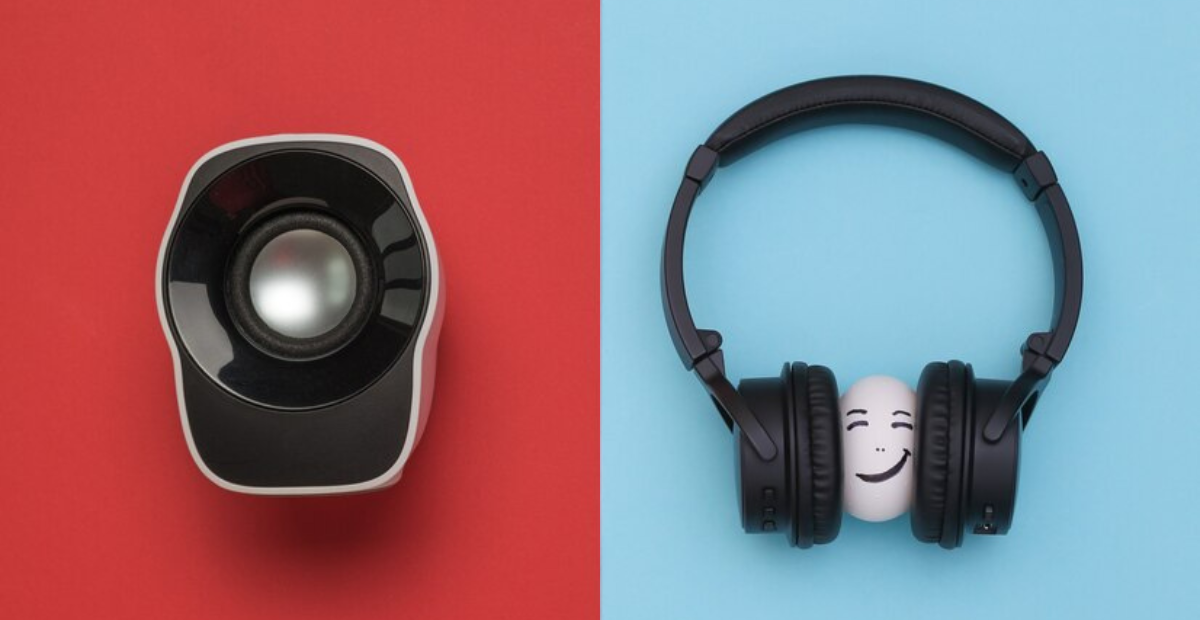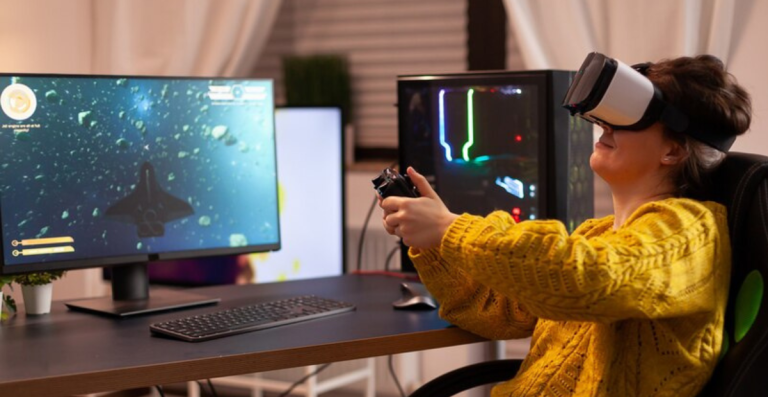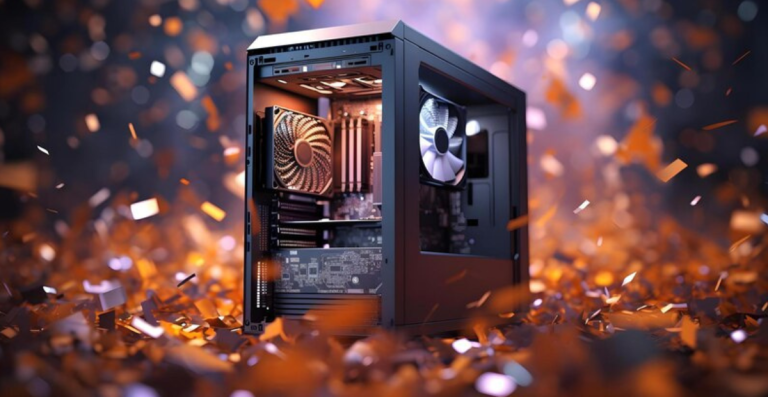Audio Solutions for Gamers and Professionals: Headsets vs Speaker Systems

In both professional creative work and gaming, clear, immersive sound is essential. The proper audio equipment can make or ruin your experience, whether you are editing intricate audio for a video project or immersed in a competitive match. Depending on how, where, and why you use them, two of the most popular options, gaming headsets and speaker systems, offer varying advantages.
Accurate spatial audio cues and fast reactions are crucial for gamers. Comfort and adaptability might be equally crucial for professionals like streamers, editors, and content producers. Making an informed decision that suits your environment and workflow will be made easier if you are aware of the variations in features, performance, and setup. To assist you in selecting the best audio partner, let’s contrast the essential features of speaker systems and headsets.
Headset Essentials
With features suited for individual use, gaming, and professional headsets are made for concentrated, immersive listening. What distinguishes a high-quality headset is the following:
- Over-ear/on-ear versions for noise isolation: Over-ear designs surround the ear to reduce background noise, helping you stay focused in loud or shared environments. On-ear models offer portability and comfort, though with slightly less isolation.
- Built-in microphone to enable communication: A built-in mic allows for real-time voice chat in multiplayer games or during online meetings. High-end models like the HyperX Cloud II Wireless feature noise-canceling mics for crystal-clear communication.
- Ear cushions for comfort and prolonged wear: Memory foam and breathable materials help reduce fatigue during long sessions vital for streamers or editors who wear them for hours.
- Wireless/wired connectivity: Wired headsets typically offer lower latency, while wireless options provide freedom of movement. Products like the SteelSeriesArctis Nova 7 offer both modes for flexibility.
- Design and Comfort: Adjustable headbands, lightweight materials, and ergonomic shapes make a big difference for extended use, especially in professional settings.
- Communication Capabilities: Many headsets integrate mic monitoring, detachable boom mics, or even AI noise suppression for clearer input, enhancing usability in both gaming and production.
- Audio Performance: From stereo setups to virtual 7.1 surround sound, headsets deliver tight, directional audio ideal for competitive play. The Logitech G PRO X is a popular example among esports players.
- Special Features: Some models include RGB lighting, programmable audio profiles, or app-based EQ adjustments to fine-tune the sound for different tasks.
Speaker System Essentials
Speaker systems are perfect for professional multimedia work, immersive solo play, and cinematic experiences because they are made to produce sound that fills an entire room. Their capabilities are defined by these fundamentals:
- Multiple speaker units: A full system often includes separate left, right, and center channels for accurate soundstage reproduction. This enhances immersion, especially in spatially rich games and video editing environments.
- Subwoofers for improved bass response: A dedicated subwoofer delivers deeper, punchier lows, useful for games with heavy action or editing tracks with layered sound. The Logitech Z906 system is a popular choice for its THX-certified sound and powerful subwoofer.
- Versatility to allow playback of diverse media: Speaker systems are suitable for gaming, music, movies, and streaming content. They provide a broader and more dynamic listening experience across different formats.
- Components and Configuration: These setups can range from 2.0 to 5.1 or 7.1 channels. Some, like the SteelSeries Arena 9, offer wireless rear speakers for flexible placement and cleaner setups.
- Audio Characteristics: Compared to headsets, speaker systems deliver a wider soundstage and more natural acoustics, making them ideal for those who want a home-theater-style gaming setup.
- Connectivity: Inputs like optical, RCA, Bluetooth, and USB offer compatibility with PCs, consoles, and audio interfaces. Professionals benefit from having multiple input options for different devices.
- Physical Considerations: While offering excellent sound, speaker systems require more space and careful positioning for optimal output. Acoustic treatment or placement strategy can further enhance quality.
Headsets vs. Speaker Systems: What Are the Differences Between Them?
There are other considerations besides sound quality when deciding between a speaker system and a gaming headset. Both provide unique advantages suited to various settings and user requirements. Knowing how these two audio solutions compare across important criteria can help you make the best choice, whether your goal is to produce multimedia content, achieve competitive precision, or just enjoy immersive storytelling.
To help you choose the one that best suits your daily routine and priorities, this section deconstructs their variations in terms of sound quality, comfort, communication, and versatility.
Audio Quality and Immersion
For both professional and gaming applications, sound quality and immersion are essential. Your performance and level of engagement can be significantly impacted by the audio delivery of speaker systems and headsets.
Headsets
Headsets isolate the ears and block out outside noise to produce clear, detailed sound. This improves immersion by enabling users to detect in-game sounds that are crucial for competitive gaming, such as footsteps or distant gunfire.
By simulating spatial audio, virtual surround sound technologies provide directional cues that increase the accuracy of gameplay. For example, the precise positional audio of the Logitech G PRO Gaming Headset makes it a favorite.
- Precise directional audio improves situational awareness
- Noise isolation reduces distractions in noisy environments
- Virtual surround sound simulates a 3D audio space for deeper immersion
Speaker Systems
Sound from speaker systems fills the space, making listening feel open and natural. They are perfect for multimedia work and cinematic gaming because they have a richer bass response and a wider frequency range.
Multiple channels replicate real surround sound, and subwoofers add powerful low-end depth. A strong 5.1 setup offered by the SteelSeries Arena 9 improves immersion in both videos and games.
- Room-filling sound creates a more natural and open atmosphere
- Subwoofers enhance bass for impactful audio effects
- True surround sound setups improve spatial awareness in larger spaces
Communication and Microphone Quality
Effective communication is essential for both professional and gaming teamwork. Headsets and speaker systems differ greatly in terms of microphone quality and configuration.
Headsets
Built-in microphones on headsets allow for crystal-clear, real-time voice chat. In order to ensure that your voice is heard clearly, many models come equipped with noise-canceling technology. For instance, the HyperX Cloud Alpha headset is well-liked by both streamers and gamers due to its clear microphone quality and dependable voice transmission.
- Integrated microphones simplify setup and use
- Noise-canceling mics improve voice clarity in noisy environments
- Detachable or adjustable boom mics offer flexibility and comfort
Speaker Systems
Speaker systems usually lack built-in microphones, so communication requires external devices like standalone microphones or headsets. While this may add complexity, using a dedicated mic can provide superior audio input quality, especially for professional content creators who prioritize voice fidelity.
- External microphones allow higher-quality audio capture
- Flexibility to choose specialized mic types (condenser, USB, etc.)
- Requires additional setup compared to the headsets’ integrated solutions
Comfort and Ergonomics
For extended gaming sessions and business use, comfort is crucial. There are significant differences in how speaker systems and headsets manage wearability and physical impact.
Headsets
In order to guarantee comfort over long periods of time, headsets emphasize ergonomic design with padded ear cushions and adjustable headbands. Heat accumulation is decreased by high-quality materials like memory foam and breathable textiles. One of the best options for long workouts is the Beyerdynamic DT 700 Pro X, which is well-known for its luxurious cushioning and lightweight feel.
- Padded ear cups reduce pressure and fatigue
- Adjustable headbands offer a customized fit
- Lightweight designs improve comfort for long wear
Speaker Systems
By enabling users to listen without a device on their head or ears, speaker systems provide comfort. This “non-contact” listening completely relieves physical strain and allows for greater mobility. However, depending on the volume and the acoustics of the room, spending hours sitting close to speakers can lead to auditory fatigue.
- No physical contact reduces discomfort and pressure
- Allows natural head movement without cables or wearables
- Requires appropriate volume and room setup to avoid ear strain
Awareness of Space and Ambient Sound
Headsets
Virtual surround sound technologies are frequently used in headsets to replicate spatial audio. Particularly helpful in competitive gaming, this aids users in identifying directional cues such as enemy positions or footsteps. Reacting swiftly to in-game sounds is made easier by these virtual systems, which give the impression of a 3D audio space.
Systems of Speakers
True surround sound is produced by speaker systems, which use several speakers positioned throughout the space. Users can experience sounds as they would in real life thanks to this setup’s realistic and immersive soundstage.
By filling the space with rich, room-filling audio, systems such as Vizio’s 5.1-channel M Series improve spatial awareness, which is advantageous for media consumption and gaming.
Price and Value
When choosing between speaker systems and headsets, cost is frequently a determining factor. Both provide choices at different price points, but how much they are worth will depend on your particular requirements and usage.
Headsets
The cost of headsets varies greatly, ranging from inexpensive models that cost about $30 to high-end models that cost more than $2,000. For casual gamers, entry-level headsets frequently offer good audio and microphone quality. Advanced features like better noise isolation, high-quality materials, and adjustable sound profiles are available in high-end models.
- Budget headsets ($30–$100) provide basic audio and mic performance
- Mid-range models ($100–$300) include enhanced comfort and virtual surround sound
- Premium headsets ($300+) deliver top-tier audio fidelity, build quality, and features
Speaker Systems
Due to the intricacy of parts like multiple speakers and subwoofers, speaker systems are typically more expensive. Configuration, brand, and audio quality all affect price. Dedicated setups where multimedia versatility warrants the investment are usually better suited for these systems.
- Entry-level systems start around $150 for basic stereo speakers
- Mid-range setups ($300–$800) include subwoofers and partial surround sound
- High-end systems ($800+) offer full surround sound with advanced features
Versatility and Multiple Uses
When selecting audio equipment, versatility is crucial, particularly for users who balance multimedia consumption, professional work, and gaming.
Headsets
Headsets are ideal for on-the-go gaming, videoconferencing, and content creation because of their extreme portability and convenience. In a variety of contexts, their built-in microphone and noise-isolation features facilitate focused listening and clear communication. Streamers favor models like the SteelSeriesArctis Pro because they strike a balance between microphone clarity and sound quality.
Systems of Speakers
Speaker systems work best in fixed configurations where multimedia versatility and immersive sound are essential. They are excellent at producing loud audio for movies, music, and gaming, but they are not as portable as headsets. Speakers placed correctly create a captivating atmosphere that is perfect for professional editing spaces or home entertainment.
Headsets vs. Speaker Systems: Who’s Better for Your Ears?
The decision between speaker systems and headsets ultimately comes down to your individual requirements and tastes. Headsets are perfect for shared spaces and on-the-go use because they provide noise isolation, portability, and integrated communication tools. Speaker systems benefit dedicated setups by offering a better soundstage and immersive audio, but they also take up more room and may disturb other people.
To choose the best option for you, take into account your surroundings, usage habits, and comfort preferences. The proper selection improves your gaming and professional audio experiences, and both devices have different functions.
| Feature | Headsets | Speaker Systems |
| Audio Quality | Detailed sound, noise isolation, immersive | Wider sound spectrum, true surround, rich bass |
| Communication | Built-in microphone, clear voice | Usually no built-in mic, external mic needed |
| Comfort & Ergonomics | Padded cushions, adjustable fit, wearable | No physical contact, freedom of movement |
| Spatial Awareness | Virtual surround sound for directional cues | True surround with multiple speakers |
| Price Range | $30 to $2,000+ | $150 to $800+ (varies by setup) |
| Environmental Suitability | Quiet/shared spaces | Dedicated spaces like game rooms |
| Versatility | Portable, good for gaming and content creation | Fixed setups for gaming, music, movies |






